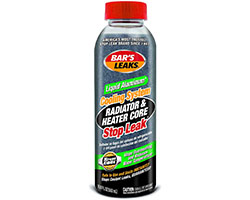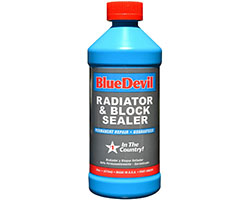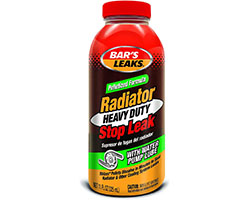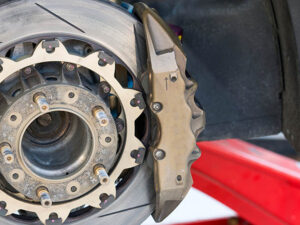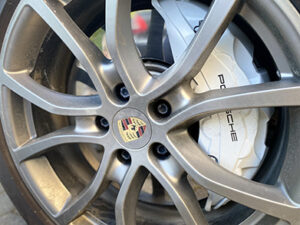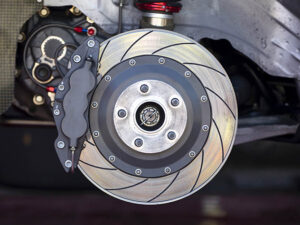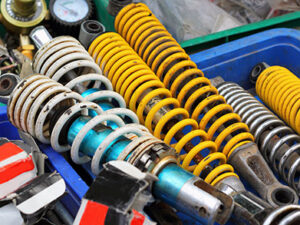Home \ Shop \ Engine & Efficiency \ Radiator Stop Leaks
Best Radiator Stop Leaks and How To Use Them
Why use radiator stop-leak, how does it work, and what features are important when choosing the best one?
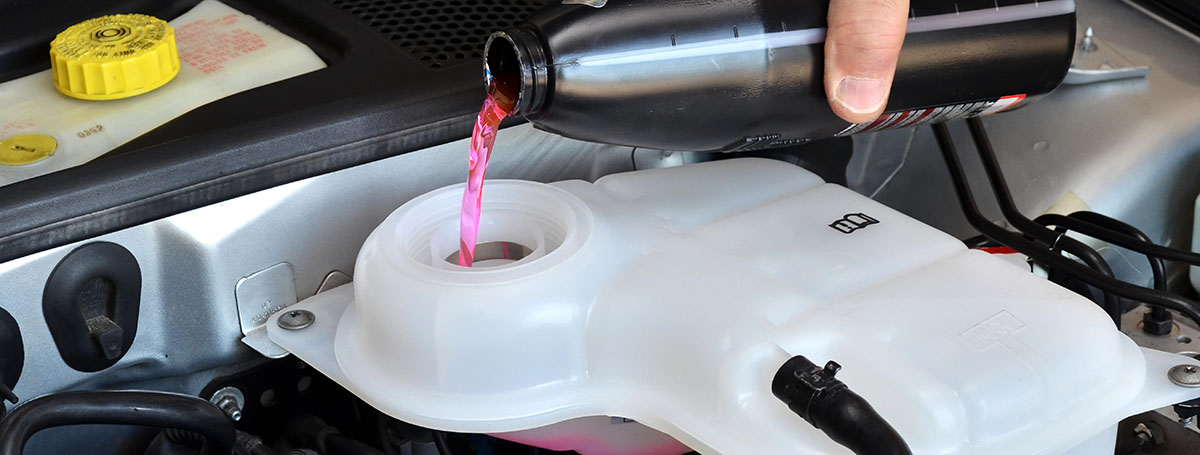
- 1. What Is a Radiator Stop Leak?
- 2. Stop Leak Vs. Radiator Repair
- 3. How Does Radiator Stop Leak Work?
- 4. The Best Raditor Stop Leaks Review
- 5. Bar's Leaks 1186 Liquid Aluminum Stop Leak
- 6. BlueDevil Radiator & Block Sealer (00205)
- 7. Bar's Leaks Pelletized Radiator Stop Leak (PLT11)
- 8. ATP AT-205 Re-Seal Stops Leaks
- 9. K-SEAL Multi-Purpose Coolant Leak Repair (ST5516)
- 10. AlumAseal Radiator Stop Leak and Conditioner Liquid (ASLC16)
- 11. Prestone Radiator Stop Leak (AS145)
- 12. Key Features To Look For
- 13. How To Use Radiator Stop Leak?
As vehicle designers eke out more performance from passenger cars, aerodynamic efficiency is playing an increasingly important role – not only in vehicle dynamics, but also in fuel efficiency and emissions. This invariably means smaller frontal areas with vital components such as the engine’s heat exchanger, better known as the radiator, packaged into very confined spaces.
While this has obvious aerodynamic advantages it does, however require highly efficient heat exchanger design. For instance; in motor racing, ‘micro tube heat exchangers’ are becoming the new norm in radiator construction.
A micro tube heat exchanger is fabricated using hundreds, sometimes thousands of small tubes, usually stainless-steel, with external diameters of between 0.5 to 1.0mm. This design results in cooling conduits with a high surface area to unit volume ratio, which translates into superior cooling efficiency.
However, the complexity of radiator design (even in current road cars) and the lack of access means that locating or repairing radiator leaks can be incredibly difficult and usually prohibitively expensive.
What Is a Radiator Stop Leak?
To make matters worse, positioned at the front of the car, the radiator is prone to stone damage, where an errand stone perforates a tube while the vehicle is being driven; which means the engine runs the risk of overheating if not repaired without delay.
Usually, faced with a leaking radiator, a car owner has two options:
- Replace the radiator with a new one; which is both expensive and likely to leave the vehicle unserviceable for hours, if not days
- Repair or re-core the damaged tubes, which will be costly and likely see the vehicle off-road for a few days
But, there is a third option – one which is cheap, quick and above all can effectively be carried out by a novice without the need of any tools or equipment, namely the use of a radiator sealant, otherwise known as “radiator stop-leak”.
Using a radiator sealant allows a stranded motorist to effect a roadside repair, without any sophisticated equipment, and safely drive the vehicle to the nearest or most convenient workshop. Or faced with an expensive repair bill for an aging radiator an owner could even consider radiator stop-leak as a near-term alternative to an expensive replacement.
It is for exactly these reasons that radiator sealant additives and radiator stop-leaks have found favor with thousands of consumers: Not only does it save commuters from being stranded by virtue of ‘temporarily’ plugging the leak, but by using a premium quality product, such as BlueDevil’s Radiator & Block Sealer, it is quite possible to effect what can be considered a permanent repair, without removing the radiator.
For the uninitiated this may sound too good to be true, and they may well ask: “How does radiator stop-leak work?”
Stop Leak Vs. Radiator Repair
The radiator of a modern car is a reliable device that can work throughout the entire life of the car. Car radiator repair is most often required when it is externally damaged. Also sometimes, the best way to solve the problem – is to buy a new radiator.
To solve the issue of engine cooling system leakage, it is necessary to find its cause. First of all, you need to understand the scale of the leak, which the driver can understand by the amount of coolant outside the car. If you have a large leak, you need to urgently go to a service station, or stop using the car. Small leaks can be solved quickly and sometimes for a long time with the help of a radiator stop leak. But before using it, you need to understand that it is rather a temporary solution in case of a small leak of coolant.
In the process of work, the thin-walled material, as a rule, it is aluminum, is subjected to significant and regular temperature deformations, with long periods of operation, fatigue cracks may appear in the walls of tubes or tanks, which lead to coolant leakage. In older cars, corrosion may appear in the radiators during operation. Since antifreeze consists of 50% water, there are all conditions for its occurrence. To extend the service life of the radiator, periodic flushing of the cooling system is recommended, as deposits form in it over time, which will interfere with fluid movement and heat exchange. It is also important to use a radiator stop leak according to the manufacturer’s recommendations. Some of the popular manufacturers suggest draining the coolant and then using radiator stop leak with clean water to achieve a sealing effect. So you have to be confident that you are aware of these rules.
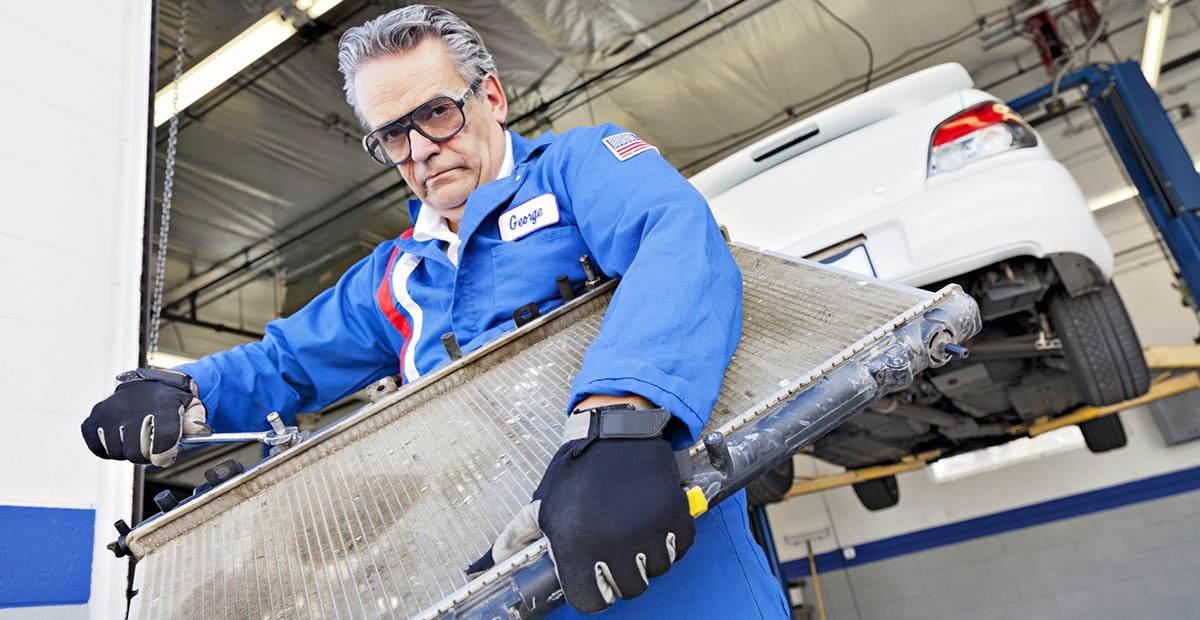
How Does Radiator Stop Leak Work?
Most early formulations of radiator stop-leak relied on a compound that hopefully swelled or gummed as it exited the cooling system through the perforation, thereby sealing the leak. However these products would often dry out in a short time, allowing the leak to reappear.
So, over time products that typically contained a mixture of wood flour, acrylamide, gelatin, sodium alginate, benzotriazole, sodium nitrite and ethylene glycol were succeeded by more sophisticated compositions based on oxygen-reactive chemical compounds capable of bonding to steel, copper and aluminum to produce a nearly permanent seal.
The use of an oxygen-reactive base in these products is crucial to ensure the sealant is only triggered when it comes into contact with oxygen, thereby making sure that the small tubes in the radiator core are not ‘sealed’ by a compound that hardens unpredictably. At the same time, it is equally important that the radiator stop leak does not react with seals, hoses and metals, including aluminum, and is compatible with all corrosion inhibitors and anti-freeze/anti-boil products.
What is more, to extend the longevity of the ‘temporary’ repair, manufacturers have taken advantage of the technological advances made in micro-sphere nanotechnology to add in very small fibers as a filler, thus building a mesh that hardens and cures with temperature to provide a more permanent seal.
To further improve the performance of these sealants some manufacturers add sodium silicate to the metallic filler material. In this instance, as the temperature rises the sodium silicate particles in the liquid melt to form a plug, creating a permanent seal once the radiator cools down.
But, as is true with most automotive products, not all radiator sealants are the same, so it is important that the consumer understands the importance of evaluating the key features of each product before making a purchasing decision.
Even though the primary function of radiator stop-leaks is to offer the consumer a quick, easy and safe means to temporarily repair a leaking radiator, several manufacturers have products that offer enhanced functionality.
The functionality of some products, such as the very reasonably priced Bar’s Leaks PLT11 Pelletized HD Radiator Stop Leak, extends beyond merely sealing leaks. In this case the sealer also:
- conditions the cooling system by inhibiting rust and corrosion
- lubricating the water pump
- seals and helping to combat electrolysis.
Depending on the formulation the manufacturer uses to achieve the desired performance, radiator stop-leaks vary in their format and the way in which they are to be applied. Sealants come either in a form of:
- liquid
- powder
- tablet form
They work by being poured directly into the cooling system. Some compounds also require the system to be flushed before and after application.
It is therefore imperative that the user studies the manufacturer’s instructions and key features carefully before purchasing the product.
The Best Raditor Stop Leaks Review
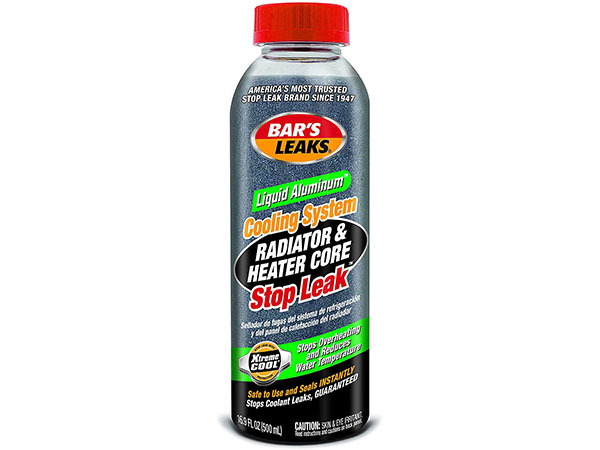
PROS
- Compact, but valuable product
- Application and use are stress-free
- It helps regulate engine temperature
- Quality-made product
CONS
- For non-frequent use
This product is one of many of the Bar’s Leaks company. The philosophy of this company is the creation of products that make automotive care and maintenance simple, easy, and affordable. This Liquid aluminum stop leak fits right into that philosophy. This product is the best in general in terms of price and functionality. The stop leak is applied by adding it to a vehicle’s cooling system through the radiator or pressurized reservoir. There isn’t a need to flush out the antifreeze because the product works with all types of antifreeze, silicate-based and non-silicate based. It can also be used in only water. However, if antifreeze is added to the system, another unit of bar’s leaks liquid aluminum should be added too.
The product is best used to treat small to medium leaks in the vehicle’s heater core or radiator. It can also be used to seal freeze plug leaks and gasket leaks. This product is a handy solution for scenarios where an engine issue triggers the temperature warning light, or for instances where smoke or steam starts to come out of the hood, mainly because the product reduces water temperature quite significantly. It costs only about $7 and has an excellent customer rating of 4.3.
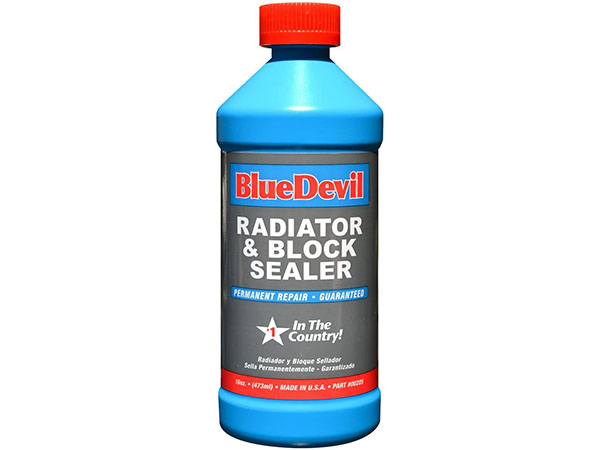
PROS
- Compatible with both petrol and diesel engines
- It performs well with all types of engine material
- Easy to use product
- Anti-clogging formula
CONS
- It is quite expensive
- For non-frequent use
This premium product is one of the most expensive on the market, but for a good reason. It features some premium qualities and benefits that are hard to find in cheaper alternatives. This sealer binds to plastic, metals, cast iron, aluminum, and alloys. It works just fine with both petrol and diesel engines, and unlike other products in its category, it effects a permanent repair to damaged or exposed regions. Many buyers usually have concerns about clogs when introducing foreign material into their radiator. This product’s content has no fibrous material or solid that can cause such to happen. However, as a general maintenance tip, if the cooling system is dirty or already clogged, it is recommended to flush the system before installing this product. This gives better results.
Installation of the product is done in a few easy steps: Remove the cap of the radiator when the engine is cold to avoid any severe injuries, and if the radiator is full, drain it to create room for the Bluedevil solution. Pour the liquid into the radiator slowly after starting your cool engine and turning up the heater to the maximum setting. Replace the radiator cap and let your vehicle run idle for forty-five minutes. You can top off the radiator with antifreeze or water. The product costs about $25.
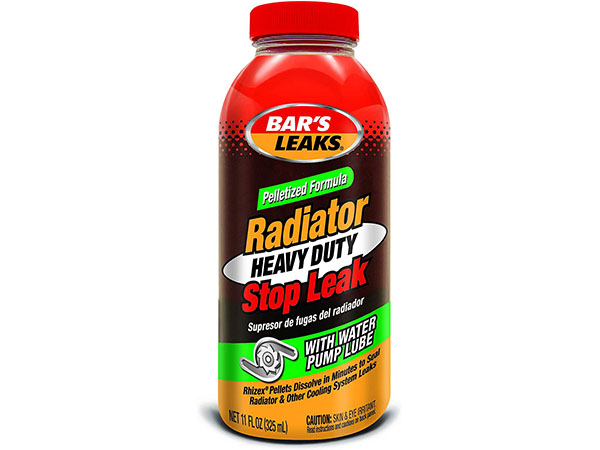
PROS
- Cheapest on the market
- Prevents damage by overheating
- It contributes to the durability
- Works well with a wide range of engine material
CONS
- Skin & eye irritant when contacting
This product is the cheapest of its kind on the market, costing only about $3. There is also free shipping for the first order placed by a buyer. Despite its price, this product has some unique features and benefits that buyers would appreciate. It adjusts the cooling system and prevents any damage that might be caused by overheating. It also prevents rust and corrosion. Customers can rest easy, knowing that this product contributes to the durability of their vehicles. They spend quite a sizable amount on purchasing their cars, and most parts of these vehicles are metal in nature. The anti-rust function of this stop leak is undoubtedly a welcome one.
This pelletized formula also lubricates the water pump seal. This can be a temporary solution if the water pump seal goes bad. A permanent and better solution will be to change the pump entirely. Bar’s Leaks also helps to control electrolysis. This is more of a precautionary benefit, such that the product balances electric current that flows as a result of differing voltages in the radiator, the heater core, and the engine coolant jacket. This 13-ounce product works effectively on plastic, metal, aluminum, and freeze plug. It has a customer review rating of 3.9.

PROS
- Multi-purpose product
- Prevents engine gasket problems
- Affordable price for this range of features
- Doesn't damage seals
CONS
- Can't be used in brake system
- Works well, but made not especially for radiators
ATP AT-205 is a $12 multipurpose stop leak product. It has a wide range of compatibilities. It restores rubber seals and engine gaskets. This is essential because gasket problems usually can lead to a host of other engine issues. The product can also be used for the transmission system of vehicles, power steering, or even for other hydraulic systems of the car. This is because the product is compatible with most gear oils, power steering fluids, and hydraulic oils. More testament to its broad range of capabilities. Unlike some other products of its kind, this does not include petroleum distillates which swell and break down seals.
The product works by conditioning rubber seals and gaskets. Once users pour its content into any vehicle systems with leaks, apart from brakes, the product’s formula blends with oil flows through such systems while they are in operation. Conditioning happens during circulation and holes are blocked. It takes the plasticizer at most five hours from installation to seal most leaks, provided there isn’t extensive damage in systems. The product has been rated 4.3 by customers.
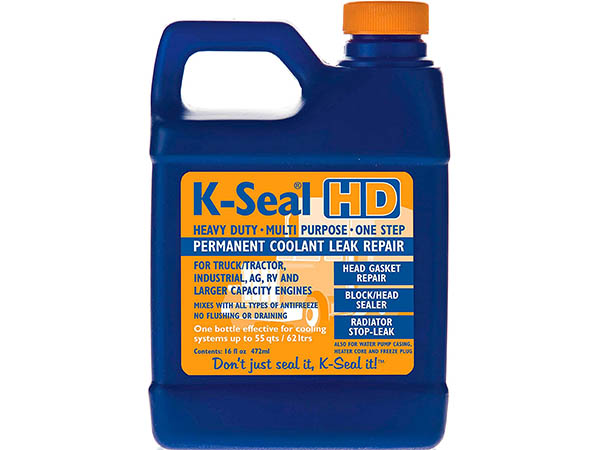
PROS
- Suitable for heavy-duty vehicles
- Seals all cooling system components
- It doesn’t tamper with the efficiency of systems in its function
- Affordable price
CONS
- Not best for small-capacity engines
This sealer boasts of some excellent achievements. It is the only one to meet the ASTM D3147 standard as tested by universities. The product works within minutes of installation by creating a permanent seal within coolant systems. Its heavy-duty performance means that its range of function includes heavy-duty vehicles, like trucks and RVs. K-seal works with most engine materials and engine parts, and it doesn’t tamper with the efficiency of these systems. It is essential to mix the container’s content properly before application. The product is not selective in that it mixes well with all types of antifreeze, and no draining or flushing is required, except you already have a clogged system.
The Microfibers in K-seal are small enough by design to avoid constricting tubes in the cooling system, but are large enough to seal holes up to 0.635mm. The exposure of those microfibers causes the formula to form a permanent seal. The sealer costs $21 and has been rated 4.2 by customers.
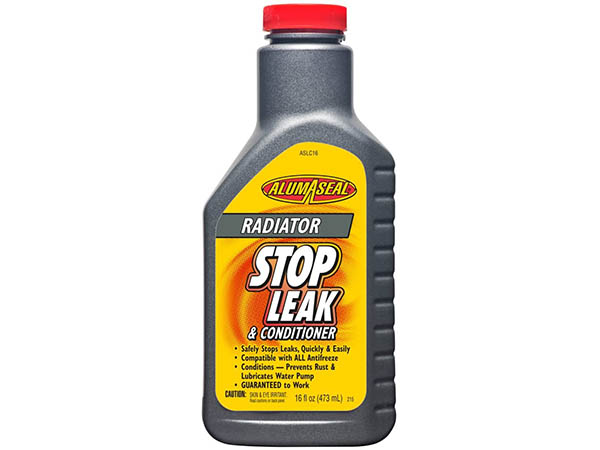
PROS
- Compatible with all types of engine materials
- Compatible with antifreeze and coolant
- Multi-purpose product
- The product is inexpensive
CONS
- Skin & eye irritant when contacting
This 16-ounce radiator stop leak is a decent quality product. It costs about $11 on the market and has a customer review rating of about 3.3. Most of this product’s features are contained in many other cheaper, more efficient options. Some of such features include its sealing abilities and effectiveness on plastic, aluminum, metal, and rubber cooling system parts of the engine. It is also compatible with most antifreeze and coolant, and it lubricates water pumps. The first purchase of this product attracts free shipping, and it is definitely a product to consider if trying to conserve cost, or if the damage to be repaired is a minor one.
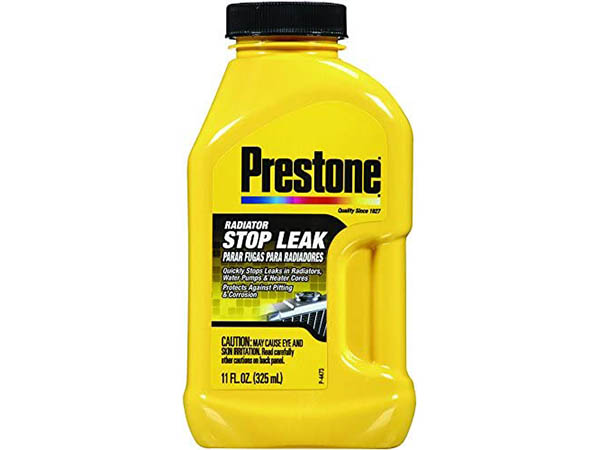
PROS
- Seals even large leaks
- Stops corrosion
- Made to stop leaks quickly
CONS
- May cause skin & eye irritration
- Temporary use only
Prestone Stop leak is a patented formula that does the usual as a sealer and even goes the extra mile. This product not only seals leaks, but it also goes ahead to resolve the corrosive conditions that cause such. With its combination of synthetic and organic elements, the product boosts corrosion inhibitors. Hence, its seals all leaks with area up to 0.02mm x 0.5mm. It also prevents further leaks.
Key Features To Look For
When shopping for a radiator stop leak the buyer may have a novel requirement, such as the coolant system cannot be flushed before application, or maybe the leak is not in the radiator but rather in the passenger compartment’s heater box, so here are some important features to consider before deciding on a product:
- Ease of application
If the car is stranded next to the road it may be impractical to flush the system before adding the sealant. However, most stop-leaks are easy to use, so this only really becomes an issue under special circumstances.
- Is the sealant compatible with anti-freeze/ anti-boil?
It is important that the buyer determines whether the stop-leak requires the cooling system be drained of anti-freeze before application. It is advisable to only consider products that are compatible with other coolant additives, as it is not desirable to operate an engine without antifreeze for an extended period.
- Does the particular brand of radiator stop-leak work with aluminum, steel and plastic materials?
With composite radiator construction where the tanks are often manufactured from Glass Reinforced Plastic and the core from aluminum it is vital to ensure the solution is compatible with these materials.
- Dimensions of the perforation that the sealant is expected to plug
While radiator sealants work best on small perforations, laboratory test standard specifications for stop-leak additives, such as the ASTM D6107, are usually conducted with perforations measuring 0.64mm for a round hole and 0.254mm for a slot. Should the hole requiring repair be larger than this, it is important to seek out a product specifically designed for this purpose – or consult a specialist.
- Time to cure
This is extremely important if the stop-leak is to form part of an emergency breakdown kit: The user would be wise to opt for a quick setting solution.
- Product cost versus performance
Even though radiator sealers are a fraction of the cost of fitting a new radiator, or recovering the existing part, it is always prudent to check and compare pricing.
Usually the cost of the product is a good indicator of the quality of the repair to be expected – but not always. So compare specifications and features versus the cost before making a decision.
With features and specifications being equal it is always worth the peace of mind to spend a little more for the extra confidence that a quality stop leak will not clog the cooling system or is safe to use to repair the heater core, as is the case with Bar’s Leaks versatile 1186 Liquid Aluminum Stop Leak that is formulated to seal radiators, freeze plug leaks, as well as gasket and heater core leaks.
- Product’s brand reputation
While the efficacy of good radiator stop-leaks are undeniable, there is an inherent risk that the product, not only fails to deliver the performance claimed, but actually damages or clogs the coolant system which could lead to an expensive radiator replacement or even severe engine overheating.
For this reason it is important for buyers to remain with well trusted brands that have built up a reputation for producing a quality product – or at least doing online research as to the reliability of a particular brand’s products.
How To Use Radiator Stop Leak?
Having selected the best product for the application it is important that the manufacturer’s recommendations regarding the application of the specific stop-leak product is adhered to.
By following these 8 easy steps a user can be confident of achieving an effective repair:
- Determine the size of the leak
- Following the guide above, buy a reliable radiator stop leak
- Read the manufacturer’s instructions
- Add the stop-leak product to the coolant in the radiator
- Add radiator fluid through the radiator cap
- Start the car and bring the engine up to operating temperature – following the manufacturers recommendations
- Top up the radiator with the correct coolant mix
- Check to see the leaks have been sealed successfully
Finally, the key to a successful repair is to apply sealant at the first sign of a leak – the longer it takes to administer the solution, the greater the chance of significant radiator damage, which could lead to a costly repair or even replacement.
We do an efforts to find, research and recommend the best products. So, we may receive commissions from purchases that you make after following the links in our product reviews.


